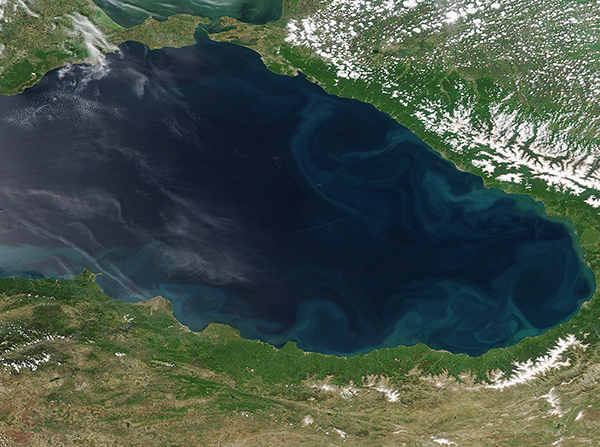Images
May 27, 2022 - Color in the Black Sea
Tweet
The dark waters of the Black Sea were colored with swirls of teal and turquoise on May 26, 2022, when the Moderate Resolution Imaging Spectroradiometer (MODIS) on board NASA’s Aqua satellite acquired a true-color image of the scene.
The jewel-toned colors are caused by large blooms of phytoplankton, which are microscopic plant-like organisms that live in these waters year-round in small numbers. When conditions are right—enough nutrients, adequate sunlight, and favorable water temperature—the organisms can begin to reproduce explosively, creating large blooms (floating colonies) that can easily be seen from space. Puffs of white in the western section of the image comes from thin cloud over the dark waters.
The waters of the Black Sea host phytoplankton blooms frequently, especially in the spring and summer. The waters of the Black Sea are particularly favorable for growth of these organisms, thanks to the water dynamics. Many of Europe’s largest rivers, including the Danube, the Dnister, and the Dnipro (also called Dnieper) dump fresh water, along with fertilizers, sediment, and runoff, into the Black Sea. The Sea also receives some salty water through the narrow Bosporus Strait, which connects it to the Mediterranean Sea through the Sea of Marmara. Because salty water is denser than fresh water, it sinks to the bottom, leaving a layer of relatively fresh water on top. The two layers mix very little, leaving the fresh, nutrient-rich layer filled with phytoplankton in the top 150 meters or so, creating a near-perfect environment for phytoplankton reproduction during much of the year.
Phytoplankton are the “primary producers” of the seas and oceans. These plant-like, microscopic algae, bacteria, and protists use chlorophyll to make their own food from sunlight and dissolved nutrients. More than 150 different types of phytoplankton have been observed in the Black Sea over the years, and they have supported a rich bounty of fish and other marine organisms.
Image Facts
Satellite:
Aqua
Date Acquired: 5/26/2022
Resolutions:
1km (616.3 KB), 500m (1.6 MB), 250m (1010.3 KB)
Bands Used: 1,4,3
Image Credit:
MODIS Land Rapid Response Team, NASA GSFC
Tweet
The dark waters of the Black Sea were colored with swirls of teal and turquoise on May 26, 2022, when the Moderate Resolution Imaging Spectroradiometer (MODIS) on board NASA’s Aqua satellite acquired a true-color image of the scene.
The jewel-toned colors are caused by large blooms of phytoplankton, which are microscopic plant-like organisms that live in these waters year-round in small numbers. When conditions are right—enough nutrients, adequate sunlight, and favorable water temperature—the organisms can begin to reproduce explosively, creating large blooms (floating colonies) that can easily be seen from space. Puffs of white in the western section of the image comes from thin cloud over the dark waters.
The waters of the Black Sea host phytoplankton blooms frequently, especially in the spring and summer. The waters of the Black Sea are particularly favorable for growth of these organisms, thanks to the water dynamics. Many of Europe’s largest rivers, including the Danube, the Dnister, and the Dnipro (also called Dnieper) dump fresh water, along with fertilizers, sediment, and runoff, into the Black Sea. The Sea also receives some salty water through the narrow Bosporus Strait, which connects it to the Mediterranean Sea through the Sea of Marmara. Because salty water is denser than fresh water, it sinks to the bottom, leaving a layer of relatively fresh water on top. The two layers mix very little, leaving the fresh, nutrient-rich layer filled with phytoplankton in the top 150 meters or so, creating a near-perfect environment for phytoplankton reproduction during much of the year.
Phytoplankton are the “primary producers” of the seas and oceans. These plant-like, microscopic algae, bacteria, and protists use chlorophyll to make their own food from sunlight and dissolved nutrients. More than 150 different types of phytoplankton have been observed in the Black Sea over the years, and they have supported a rich bounty of fish and other marine organisms.
Image Facts
Satellite:
Aqua
Date Acquired: 5/26/2022
Resolutions:
1km (616.3 KB), 500m (1.6 MB), 250m (1010.3 KB)
Bands Used: 1,4,3
Image Credit:
MODIS Land Rapid Response Team, NASA GSFC




